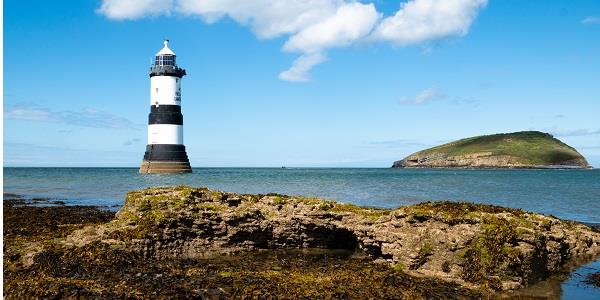
Known in Welsh as Ynys Seiriol, Puffin Island is an uninhabited island in the Menai Strait and the ninth largest island on the Welsh coast. Privately owned by the Baron Hill estate, it has an area of just 69 acres, making it an unspoilt sanctuary away from the hustle and bustle of the mainland.
In the 6th Century, Puffin Island was the site of a monastery established by St Seriol – it is said he even retired here once he reached old age and was eventually buried on the island. The monastery existed here as late as 1188 and the remains of several religious buildings can still be seen today. These include the ruins of a 12th Century church, of which only the central tower and the foundations of the nave remain. In addition, an old semaphore telegraph station was also located on the island, although it fell into ruin when electrical transmissions became the main method of communication. There is also a shipwreck; a steamship called The Pioneer, which ran ashore in 1878 while carrying a cargo of iron bars.

Today the island is a Special Protection Area and bird sanctuary. Thanks to the strong current surrounding the island, the waters are usually teaming with marine life, making it a great habitat for almost a dozen kinds of seabird, including several rare species. Currently, groups conducting research on the island include The SCAN ringing group, The University of Liverpool, The University of Roehampton, Bangor University and the RSPB. A trip here is a real treat for any keen birdwatcher!
Firstly, Puffin island is home to a huge colony of Great Cormorants. The group currently contains over 750 pairs, making it one of the largest colonies in the British Isles.
The Puffins which give the island its name all arrive to breed at the same time. Having spent the winter months at sea between the coasts of North America and Western Europe, the distinctive birds usually arrive on the island's shores during early May. The puffins only remain for a short while, usually leaving again by mid-August, so try and visit during June or July for the best chance of spotting them.

During the late 19th Century, the Brown Rat was accidentally introduced to the island and reduced the puffin population to only a handful of pairs. Thankfully, a programme to control the rat’s numbers was introduced in 1998 and today they seem to be almost eradicated. As a result, the puffin population has shown a huge improvement. These charming and popular little birds lay eggs in the cracks between rocks on the cliffs and feed by diving underwater to catch small fish.
Another interesting bird to look out for on the island is the Herring Gull, which is of major concern to conservationists. The Herring Gull is currently one of the UK’s most threatened seabirds, with their numbers declining by as much as 50% over the last 50 years. However, they seem to have found a sanctuary here.
Other birds frequently spotted on the island include Common Elder and Black Guillemot, Razorbills, Shag and Kittiwake. Fulmar and Elder duck also use the site as a breeding ground and the island is home to Atlantic grey seals throughout the year. If you’re really lucky, you might even encounter porpoise and dolphins in the surrounding waters!

People are not allowed to step foot on the island without permission, but the best way to see the birds is to join one of the summer boat trips. These run regularly from Beaumaris Pier, just a five minute drive from Henllys. The boat trips are available between Easter and October through the below providers:
- Seacoast Safaris
- Starida Sea Services
- RibRide
- Seawake
As well as enjoying the wildlife and history of the island, these boat trips are a great way to appreciate the beauty of the area, from the peaks of Snowdonia, to beautiful views of Penmon Lighthouse and Beaumaris Castle. Simply sit back, relax and enjoy this unique viewpoint… there’s really no better way to spend a sunny morning!
Once you're back on dry land, our Henllys property is the perfect place to unwind. With fantastic views, a wealth of facilities (including pool and golf course) and 93 apartments and cottages, it’s ideal for recharging those batteries.
Find out more about staying at Henllys, or any of our other properties.

